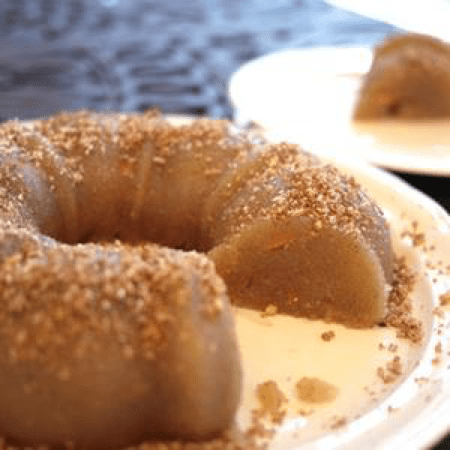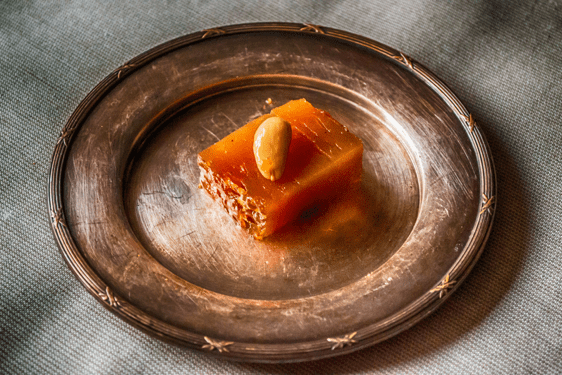Thessaly – Greek Diaspora Travel
Greek Halva Farsalon
Greek Halva Farsalon From Farsala
The Greek halva dessert will be familiar to most in the Greek diaspora, but do you know what halva farsalon is? It’s not only one of my favourite desserts, but it’s also a very different take on the traditional halva dessert. The Greek halva farsalon has a jelly like consistency and originated from Farsala in Thessaly, Greece – where it derived its name from.
What types of Greek halva dessert are there?
The popular types of Greek halva are:
- Traditional tahini halva dessert.
This is the most common type of Greek halva and comes in a number of different flavours such as:
- Vanilla
- Chocolate
- Pistachio
- Almond
- Cranberry
- Honey

- Semolina halva dessert.
This is another common type Greek halva and is lighter in both flavor and texture.

- Halva farsalon dessert.
This is the least common of the Greek halva desserts and although most in Greece will have tasted or at least be aware of the dessert, many in the Greek diaspora are unaware of this hidden gem.

What is the best halva dessert?
It really is up to personal preference when determining which of the Greek halva dessert options are best. Generally speaking, if you like desserts with a jelly/gelatin like consistency (like me), you will fall in love with halva farsalon. On the other hand, if you prefer the light and fluffy consistency of semolina, then the semolina halva is the right choice for you. Of course, if you like all things tahini flavoured, stick to the traditional tahini halva. With that said, you don’t have to be traditional in the flavour you choose, as today there are plenty of innovative flavours such as almond and dark chocolate or white chocolate and cranberry to satisfy the foodie within you.
What is Greek halva farsalon made from?
Greek halva farsalon is made from water, oil, corn flour, almonds, and a lot of sugar!
So, in case you were wondering – is it healthy to eat halva farsalon?
The answer is no.
But is sure is delicious!
Surprisingly, it’s not that difficult to make. If you’d like to try your hand at it, here is a recipe by Greek celebrity chef Akis Petretzikis.
How do you serve Greek halva farsalon?
If you’d like to take your Greek halva farsalon to the next level, serve by drizzling some sugar on top and burn with a kitchen torch to caramelize. Otherwise, serve on its own with a cake fork and a Greek coffee, any type of coffee, another bitter drink (to balance the sweetness of the halva), or simply with a glass of water.
Farsala Greece
Before you begin baking, learn about the town that this delicious dessert takes its name from.
Farsala is a town located in the region of Thessaly in Greece. About a 45 minute drive from the city of Larissa, Farsala is located within the regional unit of Larissa.

Archaeological evidence shows us that the area in which the modern day town of Farsala is located, was inhabited during the Neolithic period and especially in the 4th millennium BC. This makes the area in and around Farsala one of the oldest regions of uninterrupted occupation in Europe!
During the Mycenean period, the town of Farsala was known as Phthia and was frequently mentioned in Homer’s Iliad as the home of the army led by Achilles in the Trojan War (the contingent was called – Myrmidones).
During the Archaic and Classical period, Farsala was referred to as Pharsalos and was one of the main cities in Thessaly. Pharsalos fought on the side of Athens in the Peloponnesian War and later was incorporated in the Phillip II’s Macedonian Kingdom.

Those familiar with Roman history, will recall the crucial Battle of Pharsalus where Julius Caesar defeated Pompey – a pivotal moment in the transition of the Roman Republic to the Roman Empire.
Today, Farsala is known for its agriculture, in particular cotton and livestock. Of course, Farsala is more well-known for its unique Greek halva!
How to get to Farsala in Greece?
Although Farsala might not be on top of your travel itinerary, it’s historical significance and delicious halva is certainly worth dropping by. Especially given its convenient location if travelling from Athens to Meteora, Larissa, Trikala, Volos, or Thessaloniki. You can get there by train, bus or car.
Are you thinking of visiting Farsala?
Use Booking.com to lock in your accommodation and SkyScanner to book in your flights or hire car.
